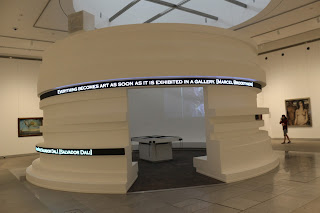My recent brief visit to Brussels provided the opportunity to see work by James Ensor, George Minne, Albert Servaes, and also contemporary art at the Cathedral of St. Michael and St. Gudula.
Housing more than 13.000 works of arts, the Ixelles Museum presents all the greatest European’s painting styles spanning four centuries. This includes realism, impressionism, luminism, neo-impressionism, symbolism, fauvism, expressionism, surrealism. This museum also owes its reputation to its prestigious collection of end-of-the century posters featuring more than one thousand original items among which many lithographs. The Museum of Ixelles’ collections are particularly rich in works of Belgian art of the 19th, 20th and 21st centuries: a period that corresponds to the history of Belgian modern art. As a result, this was my first opportunity to see work by Ensor and Minne, in particular Ensor's stunning Christ calming the Waters and Minne's L’Agenouillé.
Located at the heart of Brussels, where between 1884 and 1914 the exhibitions of Les XX and La Libre Esthétique made the city one of the artistic capitals of the late nineteenth century, Musée Fin-de-Siècle Museum (part of Musées Royaux des Beaux Arts) is distinguished by visual artists like Constantin Meunier, James Ensor, Henri Evenepoel, Fernand Khnopff, Léon Spilliaert and Georges Minne testify to the effervescent activity of this period, reflected also in all other creative fields: literature, opera, music, architecture, photography and poetry (Maurice Maeterlinck, Emile Verhaeren, Octave Maus, Victor Horta, Henry Van de Velde, Maurice Kufferath, Guillaume Lekeu and others).
Here was much work by Ensor, together with works by Paul Gauguin and Vincent van Gogh that mirrored some of Ensor's achievements, interests and themes. Around the turn of the 20th century, several artists came to live and work in the rural village of Sint-Martens-Latem, about a dozen kilometres from Ghent: George Minne, Valerius de Saedeleer, Karel and Gustave van de Woestyne, Albert Servaes. They sought to live close to the local peasants, believing that these simple folk, and the countryside itself, would help them develop a new, more profound and more inward-looking art. Religious feeling played a major role in their lives and in their work. A selection of their work can be seen at this Museum. I also particularly appreciated seeing works by Jan Toorop and Jakob Smits as well as the opportunity to see for the first time the work of Charles de Groux and Henry de Groux. I also appreciated seeing the remnants of the excellent Andres Serrano retrospective exhibition which had recently ended.
In 1937, Albert Servaes collaborated with the stained-glass glazier Florent-Prosper Colpaert to produce three large stained-glass windows for the World Exhibition in Paris, entitled, respectively The Creation of Eve, Redemption and Original Sin. In 1939, these stained-glass windows were donated by the Ministry of Economic Affairs to the church wardens of the Church of the Holy Family in Woluwé-Saint-Lambert, who housed them there. I visited the church in order to see these three pieces which are the only stained-glass windows designed by Servaes that have survived in Belgium.
The Église St-Nicolas is a delightful little church behind the Bourse which has modern stained glass from a 1950s restoration.
Finally, A Lighthouse for Lampedusa was at BOZAR. Thomas Kilpper is an artist who wants to encourage public debates on politically sensitive issues. Inaugurated on 19 June, his lighthouse invites European citizens to put pressure on their governments to bring an end to the massacre of refugees in the Mediterranean and adopt a humane and fair immigration and integration policy. The work of Thomas Kilpper refers to two very real lighthouses: the Lighthouse of Alexandria, considered one of the wonders of the ancient world, and the Cape Grecale lighthouse on Lampedusa, which is no help to the refugees, turned as it is towards Europe.
Finally, A Lighthouse for Lampedusa was at BOZAR. Thomas Kilpper is an artist who wants to encourage public debates on politically sensitive issues. Inaugurated on 19 June, his lighthouse invites European citizens to put pressure on their governments to bring an end to the massacre of refugees in the Mediterranean and adopt a humane and fair immigration and integration policy. The work of Thomas Kilpper refers to two very real lighthouses: the Lighthouse of Alexandria, considered one of the wonders of the ancient world, and the Cape Grecale lighthouse on Lampedusa, which is no help to the refugees, turned as it is towards Europe.
--------------------------------------------------------------------------------------
Nick Cave & the Bad Seeds - Jesus Alone.

























No comments:
Post a Comment